Gravitational Waves
In our everyday world, we observe all sorts of waves, including sound waves, water waves, and radio waves. But what about gravitational waves?
In the antenna of a radio station, electrons surge back and forth and produce electromagnetic waves. Suppose a very massive body like a star moved back and forth. Would it produce gravitational waves?
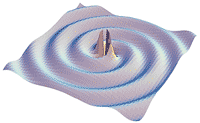
Artist’s drawing of gravitational waves emitted by a rotating system of two massive, tightly bound stars (image courtesy of Caltech/LIGO)
It may seem far-fetched to think of a star moving like this, but in fact many of the stars we see are members of binary star systems—two stars that circle around each other in a dance of mutual gravitational attraction. If the stars are massive and close together, the stars swing around each other pulled by enormous forces. Einstein, in 1915, predicted that such a system would emit gravitational waves, which would move at the speed of light, but he suspected that the radiation would be too feeble to be detected. The drawing shows a representation of these waves.
If two such stars did give off gravitational radiation, their mechanical energy would decrease, they would draw closer together, and their rate of mutual rotation would increase. So if physicists could measure the period of a binary system very precisely, they could look for evidence of gravitational radiation.
The physicists who found the evidence, Russell Hulse and Joseph Taylor, were studying pulsars—neutron stars that spin rapidly and emits sharp pulses of radio energy with extraordinary regularity. They found a pulsar whose rate of pulsing oscillated, first speeding up and then slowing down. Careful analysis showed that this variation was a Doppler shift, and that the pulsar was alternately moving towards and away from Earth as it and an unseen companion star orbited each other. The two objects rotate around each other about every eight hours, at a separation of from one to five solar radii. Since they are so close together, the gravitational forces between them are extraordinarily strong.
Painstaking, long-term measurements of the pulse arrival times revealed that the rate of rotation of the system was increasing, and in just the way that Einstein predicted 63 years before. In 1993, Hulse and Taylor were awarded the Nobel Prize in physics for this work. They had identified a source of gravitational waves. The next step would be to build a detector to observe these waves directly.
Research
Gravitational waves are hard to detect. These waves are actually faint ripples in space-time, the four-dimensional world that Einstein created in his theories of special and general relativity. As a gravitational wave passes by, objects would change their length, but by only about one part in 1021, which for the distance from the sun to Earth is about one atomic diameter. This is an extremely small effect.
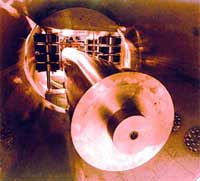
Niobium resonant mass detector at The University of Western Australia; the niobium cylinder weighs 1.5 tons; the detector is operated at liquid helium temperatures—five degrees above absolute zero. (photo courtesy of the Australian International Gravitational Research Center, The University of Western Australia)
Here are the three main categories of detectors:
1. Resonant Mass Detectors:
These consist of a large suspended metal cylinder, some tens of meters long, instrumented to detect small changes in length. (See photo.) Astrophysical theory predicts that a typical double star system with a pulsar would radiate gravitational waves at a frequency of about 1600 Hz. The length of the cylinder is chosen so the cylinder will resonate at this frequency, enabling the faint gravitational wave to produce a detectable oscillation in the length of the cylinder.
A chief limitation on the sensitivity of the resonant detectors is their small size. A different type of detector utilizes laser beams reflected over long distances.
2. Ground-based Interferometers:
To increase the magnitude of the oscillation to be measured, these detectors are interferometers with arms several kilometers long. A laser beam is split and travels several kilometers in perpendicular directions to suspended mirrors (see diagram). The reflected beams are combined and interfere, providing a pattern of light and dark that shows the relative phases of the two beams. The Laser Interferometer Gravitational Wave Observatory (LIGO), with one detector in Washington and the other in Louisiana, is currently being constructed and tested. The two detectors will be operated together to reduce the chances that noise at one or the other would mimic a gravitational wave. The photograph shows the Washington detector.
Land-based interferometers like LIGO are vulnerable to the effects of seismic noise, especially at low frequencies. This frequency dependence is important, because supermassive black holes and compact binary stars are expected to produce gravitational waves at low frequencies, below 1 cycle per second (Hz). To avoid this noise, the interferometer can be flown in space on three well-separated satellites. Note that, since a gravitational wave changes space itself, no matter is required between the mirrors.
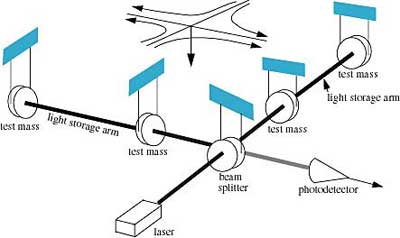
Drawing of the interferometer in the LIGO detector; the laser beam splits into two beams that pass down the long arms, reflect back, and then combine and interfere; if the length of one arm changes relative to the other, the phase of the combined light beams changes, changing the intensity at the detector. (images courtesy of Caltech/LIGO)
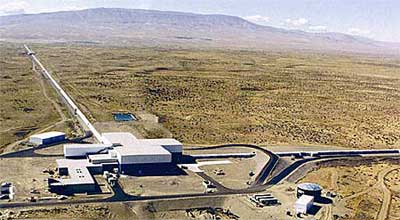
Ariel view of the LIGO Hanford Observatory; the long wings contain the interferometer beams. (photo by Gary White, courtesy of LIGO Laboratory)
3. Space-Based Interferometers:
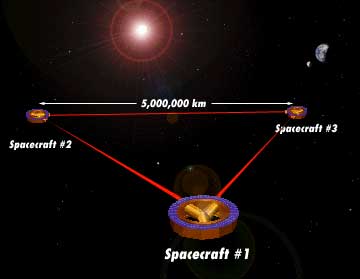
Drawing of the formation of three LISA satellites (image courtesy of NASA)
The Laser Interferometeric Space Antenna (LISA) system is located on three satellites about five million kilometers apart, in an orbit with a period of about a year. (See drawing.) LISA will be sensitive to gravitational waves from .1 x 10-3 Hz to 1 Hz. It is scheduled for launch sometime near 2011.
Since gravitational waves interact so little with matter, they would propagate virtually without change as they pass through interstellar space. Thus they are expected to provide a new window on the universe and a wealth of information very different from what we observe with electromagnetic radiation.
Links
National Center for Superconducting Applications (NCSA) University of Illinois
CalTech
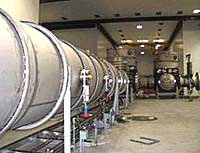
The evacuated pipe containing the laser beam in one of the arms in the LIGO detector at Livingston, Louisiana (image courtesy of LIGO)














